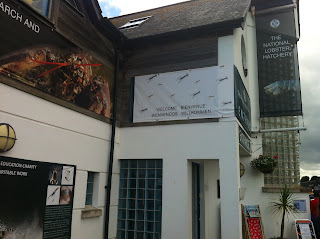 |
| The National Lobster Hatchery, Padstow |
I've liaised with Padstow in the past - when I had visiting
researchers in my laboratory from the New England Aquarium, Boston, this was on
our list of places to visit; and when I needed juvenile lobsters for exposure
studies, I would contact the hatchery. It was only at the 10th International Conferenceon Lobster Biology and Management, that I really got to know the 'hatchery lot' and we
became great friends, and colleagues. We vowed that we would stay in touch and
try to meet as often as possible in order to discuss the future of European
lobster research in the UK.
In attendance at the meeting on Friday were hatchery staff Dom Boothroyd, the general manager; Research &
Development Officer Dr Carly Daniels; Business Development Officer, Clare
Stanley and PhD student Charlie Ellis, who is part of the University of
Exeter's Falmouth Campus, but works closely with the hatchery on his research project.
 |
| A lobster with one of Dans tags on it's 'arm' |
Aside from his science, Dan has also been involved in some
outreach work. He struck up an interesting collaboration with a graphic designer and the Great North Museum. They put on an exhibition with
input from Natural History Museum called ‘Spineless’, with Dan’s work being the subject of one of the exhibits. The
aim of the collaboration was to make the kids of the northeast aware of the importance
of the lobster fishery; you can see more about the exhibit here.
Check out this great little video of Dan, talking about his research.
Lobsters from Roots and Wings on Vimeo.
 |
| A snippet from my lecture |
Charlie is currently writing up his PhD and gave us a short
overview of his findings so far. The National Lobster Hatchery's main mission
is to create a sustainable lobster fishery in Cornwall and in order to do this,
the number one research priority is to monitor the success of it's primary
charitable objective (i.e. the stock enhancement program). In order to do this,
they must be able to estimate survival rates for hatchery reared lobsters in
the wild, as well as their contribution to catches of landing-sized European
lobster. To do this, genetic analysis of Cornish lobster stocks is essential,
and something that Charlie has been working on. He has also been examining
tagging systems that will enable stakeholders to easily identify hatchery
reared animals. So far, Charlie has found that the lobsters around the Cornish
coast all seem to come from one gene pool, which is good for the release
programme which relies on volunteers to bring in berried hens (expectant lobster mums) from various locations.
I think we are a very talkative lot so we didn't have much time
for poor Carly to talk to us about her new and exciting project which focuses
on developing sea based
culture of lobsters in containers, a rearing technique that exhibits the
potential for a low carbon form of rearing with no feed costs. This is a
consortium project, led by the National Lobster Hatchery, which follows on from
an earlier
project also funnded by Innovate
UK/BBSRC. Carly completed
both her BSc and PhD projects at the hatchery, concentrating on the optimisation
of the rearing diets for early life stages of the European lobster, in order to
enhance growth, survival and health using biotic dietary supplements.
The hatchery also hosts students who work on small but important
projects and so we also heard interesting presentations from Dan Sankey, who is
working on lobster behaviour and is soon to begin an MRes at Swansea
University; and Grace Dugdale, a BSc student at Cardiff University who is
working on a placement year alongside Carly at the hatchery. Grace is looking
into the effects of probiotics on lobster juveniles. Also in attendance were Adam Bates, who is working towards an MPhil in European lobster genomics
and Joe Augier who previously completed his undergraduate project at the
hatchery and is going on to do an MRes.
In all, it was a great way to reconnect with the lobster team,
over a year after meeting at the ICWL in Mexico. I would like to acknowledge all in #Teamlobster for helping me to
write this blog post… lobster scientists, unite!

Great blog as always Charlotte, and for anyone interested in more info on the background to my own project, there is a brief video (filmed in my first year) available here https://www.youtube.com/watch?v=qJGujAJ_Tx8 and recent publications freely available here http://icesjms.oxfordjournals.org/content/72/suppl_1/i35.full.pdf+html and here http://icesjms.oxfordjournals.org/content/72/suppl_1/i91.full.pdf+html . Looking forward to following The Girl With The Lobster Tattoo for more #teamlobster updates from around the world! :) Charlie
ReplyDelete